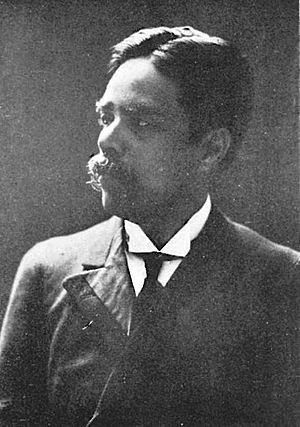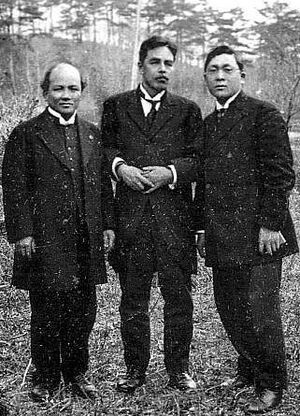Uchimura Kanzō facts for kids
Quick facts for kids
Uchimura Kanzō
|
|
|---|---|
| 内村 鑑三 | |

Uchimura Kanzō in 1918
|
|
| Born | March 26, 1861 |
| Died | March 28, 1930 (aged 69) |
| Nationality | Japanese |
| Alma mater | Sapporo Agricultural College
Amherst College Hartford Theological Seminary |
| Occupation | Writer, Christian evangelist |
| Known for | Nonchurch Movement |
Uchimura Kanzō (内村 鑑三, March 26, 1861 – March 28, 1930) was an important Japanese writer and Christian leader. He started a special kind of Christianity in Japan called the Nonchurch Movement (Mukyōkai). This movement meant people could follow Christian beliefs without needing a church building or a professional priest. Uchimura Kanzō is also known as a strong supporter of peace before World War II.
Early Life and Education
Uchimura Kanzō was born in Edo (which is now Tokyo). He was very good at learning languages from a young age. He started studying English when he was only 11 years old.
When he was 16, he went to Sapporo Agricultural College (now Hokkaido University). English was the main language used for teaching there. A teacher named William S. Clark from America helped set up the college. Clark was a Christian and taught his students about the Christian faith.
Uchimura and other students became Christians. They promised to keep studying the Bible and live good lives. This group later helped start the idea of the Nonchurch Movement. They believed they could be true to their faith without needing a traditional church.
Studies in America
In 1884, Uchimura traveled to the United States. There, he met a Quaker couple who helped him find work. Quakers are a Christian group known for their peaceful beliefs, and this idea of pacifism (being against war) greatly influenced Uchimura.
He later went to Amherst College and then to Hartford Theological Seminary. He studied a lot, but he soon returned to Japan in 1888.
A Leader in Japan
Back in Japan, Uchimura worked as a teacher. However, he often had problems because he stuck to his beliefs very strongly. Once, he refused to bow deeply to a picture of the Emperor Meiji. This was a big deal at the time, and it showed how much he valued his faith over other rules.
Because of these issues, he stopped teaching and became a writer for a popular newspaper. He became famous for speaking out against unfair things. For example, he criticized a company for polluting the environment with its copper mine.
Uchimura also strongly opposed the Russo-Japanese War. Because of his views on peace, he left the newspaper. He then started his own magazines, like Seisho no Kenkyu (Biblical Study). He also gave weekly lectures about the Bible to many people in Tokyo.
His followers believed that a formal church was not necessary for Christian faith. They also thought that ceremonies like baptism were not the most important things for salvation. This idea became known as the "Mukyōkai" or Nonchurch Movement. Many students in Tokyo were drawn to his ideas. These students later became important people in different fields.
Uchimura wrote books in English, like Japan and the Japanese and How I became a Christian. These books showed his efforts to create a unique Japanese form of Christianity. He became well-known around the world for his writings and ideas.
Images for kids
See also
 In Spanish: Uchimura Kanzō para niños
In Spanish: Uchimura Kanzō para niños






